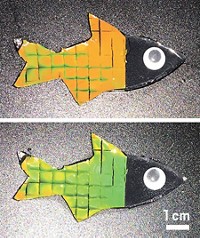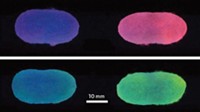Advertisement
Grab your lab coat. Let's get started
Welcome!
Welcome!
Create an account below to get 6 C&EN articles per month, receive newsletters and more - all free.
It seems this is your first time logging in online. Please enter the following information to continue.
As an ACS member you automatically get access to this site. All we need is few more details to create your reading experience.
Not you? Sign in with a different account.
Not you? Sign in with a different account.
ERROR 1
ERROR 1
ERROR 2
ERROR 2
ERROR 2
ERROR 2
ERROR 2
Password and Confirm password must match.
If you have an ACS member number, please enter it here so we can link this account to your membership. (optional)
ERROR 2
ACS values your privacy. By submitting your information, you are gaining access to C&EN and subscribing to our weekly newsletter. We use the information you provide to make your reading experience better, and we will never sell your data to third party members.
Synthesis
Silkworms’ Colorful Diet
Slipping rhodamine dyes in with mulberry leaves is a potential green, low-cost method for making colored silks
by Stephen K. Ritter
February 21, 2011
| A version of this story appeared in
Volume 89, Issue 8
In a colorful twist on silk production, scientists in Singapore are having silkworms gobble up dyes that colorize the worms and their silk cocoons (Adv. Mater., DOI: 10.1002/adma.201003860). The approach is a potential low-cost, environmentally friendly method for making colored silks that avoids traditional chemical dyeing. A silkworm’s diet is known to affect its color and the color of the silk it produces. But the color change of the silk is largely limited to the outer sheath of the fiber, a gummy protein called sericin. This layer must be removed enzymatically to get at silk’s usable fiber core, a protein known as fibroin, which doesn’t normally take up pigments. Researchers led by Ming-Yong Han of Singapore’s Agency for Science, Technology & Research fed silkworms fluorescent rhodamine dyes mixed in with mulberry leaves, the silkworms’ favorite food. Various concentrations of single rhodamines and mixtures of rhodamines caused the worms to change color and produce a rainbow of silk cocoons in which the color is incorporated into fibroin. As an added bonus, under UV light the rhodamine-infused silk luminesces in different colors. The researchers suggest hydrophilic-hydrophobic interactions between the dye molecules and fibroin, which were missing in previous dietary silk-coloring attempts, make the colorful silks possible. It’s not clear yet whether the new silks are colorfast.






Join the conversation
Contact the reporter
Submit a Letter to the Editor for publication
Engage with us on Twitter